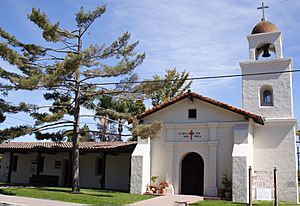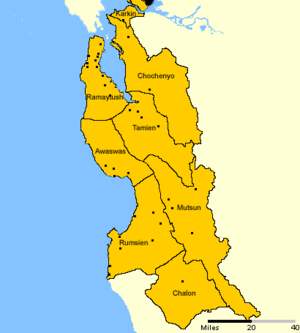Awaswas facts for kids

Map of the Awaswas area, with the Native American tribes within labeled
|
|
| Regions with significant populations | |
|---|---|
| Previously |
|
| Languages | |
| Awaswas language | |
| Related ethnic groups | |
| Ohlone: Ramaytush, Tamien, Mutsun and Rumsien peoples |

The Awaswas people were one of the many groups of Ohlone Native Americans. They lived in what is now Santa Cruz County in Northern California. Their home was in the Santa Cruz Mountains and along the coast. This area stretched from modern-day Davenport to Aptos. The Awaswas people also called themselves the Santa Cruz people. In their own language, this land was known as Aulinta.
They spoke the Awaswas language. This language was part of the Costanoan language family. It became the main language used at the Mission Santa Cruz. However, experts believe that "Santa Cruz Costanoan" might have been several different dialects. It was more about where people lived than one single language.
The Awaswas lands were next to the Pacific Ocean on the west. Other Ohlone groups lived on their other borders. The Ramaytush were to the north. The Tamien were to the east. The Mutsun and Rumsien were to the south. In 1770, about 600 Awaswas people lived in the area.
Life During the Mission Era
During the time of the Spanish missions in California, the lives of the Awaswas people changed greatly. The Mission Santa Cruz was built in their territory in 1791. Many Awaswas people were brought to this mission. They were baptized and lived there. They were taught about the Catholic faith. These people were called neophytes or Mission Indians. The missions stopped operating in 1834. This happened when the Mexican Government took over.
Awaswas Villages and Communities
The Awaswas people lived in many different villages. For example, the Sokel lived in the area of Aptos. The Chatu-mu lived near where the city of Santa Cruz is today.
People from the following villages came to live at Mission Santa Cruz. These villages were all located in what is now Santa Cruz County:
- Achilla
- Aestaca
- Agtisrn
- Apil
- Aulintac
- Chalumü
- Chanech
- Chicutae
- Choromi
- Coot
- Hauzaurni
- Hottrochtac
- Huachi
- Hualquilme
- Huocom
- Locobo
- Luchasmi
- Mallin
- Nohioalli
- Ochoyos
- Onbi
- Osacalis (Souquel)
- Payanmin
- Sachuen
- Sagin
- Shiuguermi
- Shoremee
- Sio Cotchmin
- Tejey
- Tomoy
- Turami
- Utalliam
- Wallanmi
- Yeunaba
- Yeunata
- Yeunator
Awaswas People Today
In 2011, a special march took place in Santa Cruz. It was held to protect a place called "the Knoll." This site is very old, about 6,000 years old. It is a burial site for a child. The Knoll is located near Branciforte Creek.
Today, Awaswas people are part of the Amah Mutsun tribal band. These are people who can show they are descendants of those at Missions San Juan Bautista and Santa Cruz. In 2012, the Amah Mutsun Tribal Chairman, Valentin Lopez, said that tribe members are spread out. Not many can afford to live in their historic lands anymore. Many now live in the Central Valley.


